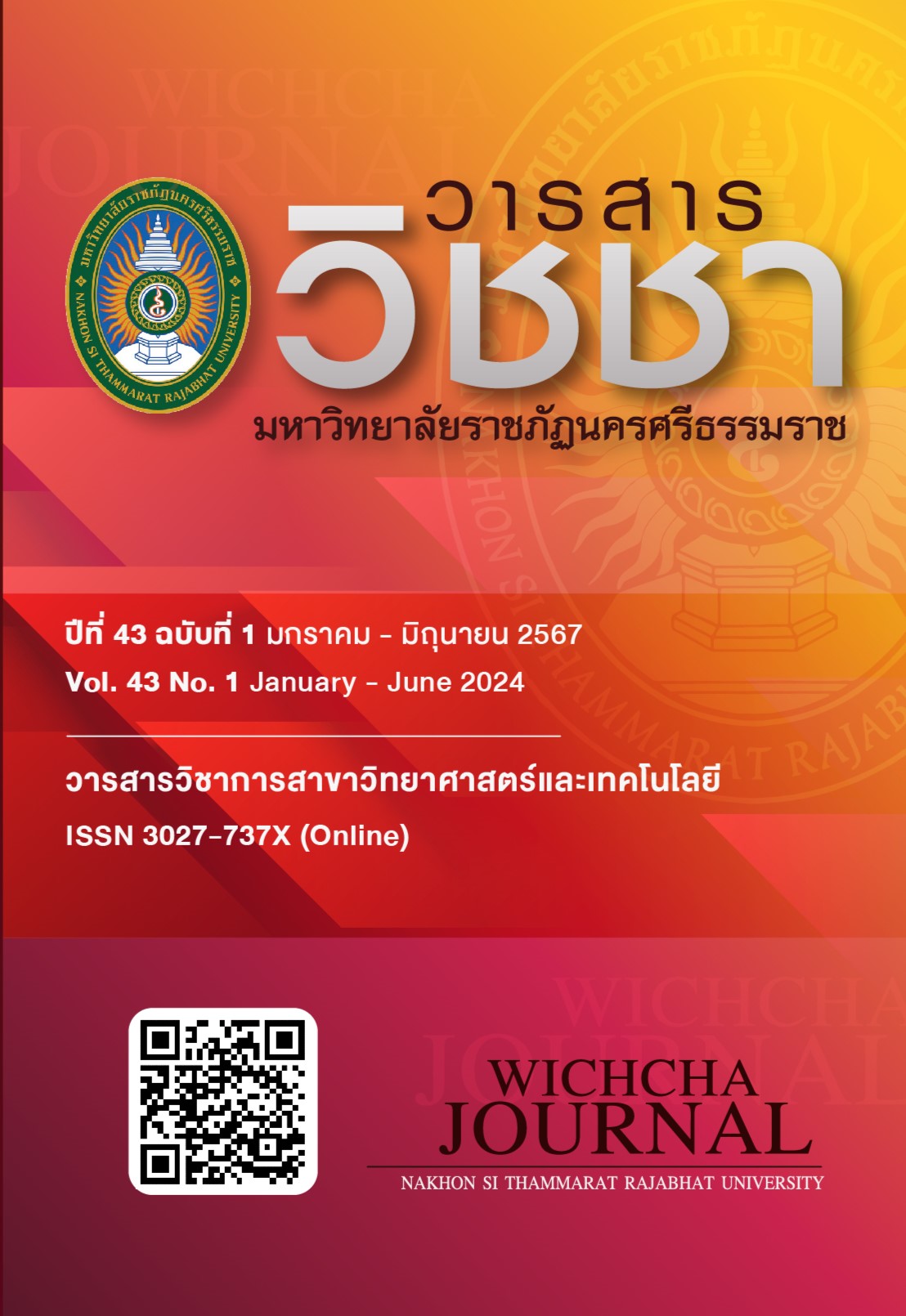Potential of Methane Gas Production from Food Waste and Green Waste
Main Article Content
Abstract
This research objective was to study the potential of methane gas production from food waste and green waste. Both of wastes were obtained from Electricity Generating Authority of Thailand Bangkruai Nonthaburi. Microorganism for methane production system was obtained from upflow anaerobic sludge blanket (UASB) system. The operation of methane production was operated in 10 liters of completely stirred tank reactor. The material ratio was 1:1:1, a total of solid 2.5% and fermentation time was 288 hours. The sample was collected from solution and gas for investigated the related parameters were pH, cumulative total gas, component of biogas. These parameters related to calculation kinetic methane production. From the research results, it was found that pH from operation time from potential of methane gas production from food waste and green waste was 6.90 - 7.42, highest methane gas production was 70.19%, cumulative biogas was 1,731.33 milliliter (ml), and cumulative methane was 404.76 ml, respectively. For Kinetic methane production, maximum methane production rate 3.197 ml hr-1, maximum methane 399.596 ml. Therefore, this research can be used as an information to support the food waste and green waste utilization as a raw material for biogas production for government and private sectors in order to achieve the sustainable development goal. Sustainable development goals (SDGs) 7.2, could increase the proportion of renewable energy in the world in 2030.
Article Details

This work is licensed under a Creative Commons Attribution-NonCommercial-NoDerivatives 4.0 International License.
เนื้อหาและข้อมูลในบทความที่ลงตีพิมพ์ในวารสารวิชชา มหาวิทยาลัยราชภัฏนครศรีธรรมราช ถือเป็นข้อคิดเห็นและความรับผิดชอบของผู้เขียนบทความโดยตรง ซึ่งกองบรรณาธิการวารสารไม่จำเป็นต้องเห็นด้วยหรือร่วมรับผิดชอบใด ๆ
บทความ ข้อมูล เนื้อหา รูปภาพ ฯลฯ ที่ได้รับการตีพิมพ์ในวารสารวิชชา มหาวิทยาลัยราชภัฏนครศรีธรรมราช ถือเป็นลิขสิทธ์ของวารสารวิชชา มหาวิทยาลัยราชภัฏนครศรีธรรมราช หากบุคคลหรือหน่วยงานใดต้องการนำข้อมูลทั้งหมดหรือส่วนหนึ่งส่วนใดไปเผยแพร่ต่อหรือเพื่อการกระทำการใด ๆ จะต้องได้รับอนุญาตเป็นลายลักษณ์อักษรจากวารสารวิชชา มหาวิทยาลัยราชภัฏนครศรีธรรมราชก่อนเท่านั้น
The content and information in the article published in Wichcha journal Nakhon Si Thammarat Rajabhat University, It is the opinion and responsibility of the author of the article. The editorial journals do not need to agree. Or share any responsibility.
References
กรมควบคุมมลพิษ. (2564). รายงานสถานการณ์สถานที่กำจัดขยะมูลฝอยชุมชนของประเทศไทย ปี พ.ศ. 2564. กระทรวงทรัพยากรธรรมชาติและสิ่งแวดล้อม.
ประภา โซ๊ะสลาม ธัญญ์ธิดี เจริญธนภัสร์ และรัชพล พะวงศ์รัตน์. (2566). การผลิตแก๊สชีวภาพจากกากกาแฟที่ผ่านการปรับสภาพร่วมกับมูลวัวโดยการผมักแบบกะและแบบกึ่งกะ. วารสารวิชชา มหาวิทยาลัยราชภัฏนครศรีธรรมราช, 42(2), 1-15.
วนัสพรรัศม์ สวัสดี. (2564). การศึกษาความเป็นไปได้ในการผลิตก๊าซมีเทนจากการหมักร่วมระหว่างหญ้าเนเปียร์ที่ปลูกในดินเสื่อมโทรมและมูลสุกร. Journal of Applied Research on Science and Technology (JARST), 20(1), 1-8.
วิจิตรพร เจริญรัตน์ ปรีดา จันทวงษ์ จงจิตร์ หิรัญลาภ และโจเซฟ เคดารี. (2559). การผลิตก๊าซชีวภาพจากฟางข้าวร่วมกับมูลสัตว์โดยกระบวนการย่อยสลายภายใต้สภาวะไร้ออกซิเจนแบบสองขั้นตอน. Journal of Energy and Environment Technology, 3(1), 1-10.
อริศรา เรืองแสง. (2562). เชื้อเพลิงชีวภาพและชีวเคมีภัณฑ์โดยจุลินทรีย์. ขอนแก่น: คณะเทคโนโลยี มหาวิทยาลัยขอนแก่น.
เอนก สาวะอินทร์ ฌานิกา แซ่แง่ ชูกลิ่น และกัตตินาฏ สกุลสวัสดิพันธ์. (2564). การพัฒนาระบบผลิตก๊าซชีวภาพจากเศษข้าวโดยถังปฏิกรณ์ไร้อาการแบบแผ่นกั้นประยุกต์ (MABR). วารสารวิชชา มหาวิทยาลัยราชภัฏนครศรีธรรมราช, 40(1), 121-134.
APHA. (2017). Standard methods for the examination of water and wastewater. (23rd ed). Washington DC: American Public Health Association.
Forster, P., Ramaswamy, V., Artaxo, P., Berntsen, T., Betts, R., Fahey, D.W., Haywood, J., Lean, J., Lowe, D.C., Myhre, G., Nganga, J., Prinn, R., Raga, G., Schultz, M., and Van Dorland, R. (2007). Changes in atmospheric constituents and in radiative forcing. In Solomon, S., Qin, D., Manning, M., Chen, Z., Marquis, M., Averyt, K.B., Tignor, M., Miller, H.L. (Eds.). Climate change 2007: The physical science basis. Contribution of working group I to the fourth assessment report of the intergovernmental panel on climate change, pp. 129-234. Cambridge: Cambridge University Press.
Gu, Y., Chen, X., Liu, Z.Y., Zhou, X. and Zhang, Y. (2014). Effect of inoculum sources on the anaerobic digestion of rice straw. Bioresource Technology, 158, 149-155, doi: https://doi.org/10.1016/j.biortech.2014.02.011.
Housagul, S., Sirisukpoka, U., Boonyawanich, S. and Pisutpaisal, N. (2014). Biomethane production from co-digestion of banana peel and waste glycerol. Energy Procedia, 61, 2219-2223, doi: https://doi.org/10.1016/j.egypro.2014.12.113.
Hussaro, K., Intanin, J. and Teekasap, S. (2017) Biogas production from food waste and vegetable waste for the Sakaew temple community Angthong province Thailand. GMSARN International Journal, 11(2), 82-89.
Jijai, S. and Siripatana, C. (2017). Kinetic model of biogas production from co-digestion of Thai rice noodle wastewater (Khanomjeen) with chicken manure. Energy Procedia, 138, 386-392, doi: https://doi.org/10.1016/j.egypro.2017.10.177.
Macapodi, A.M.M., Bandera, A.D., Ozarraga, L.M., Macapanton, B.R., Abdullah-Pandapatan, A.A., Al-Rashid, A.R., Gubat, G.M.M. and Dimapundug, J.D. (2022). Food wastes: A review. European Modern Studies Journal, 6(5), 89-99.


